
 |
|
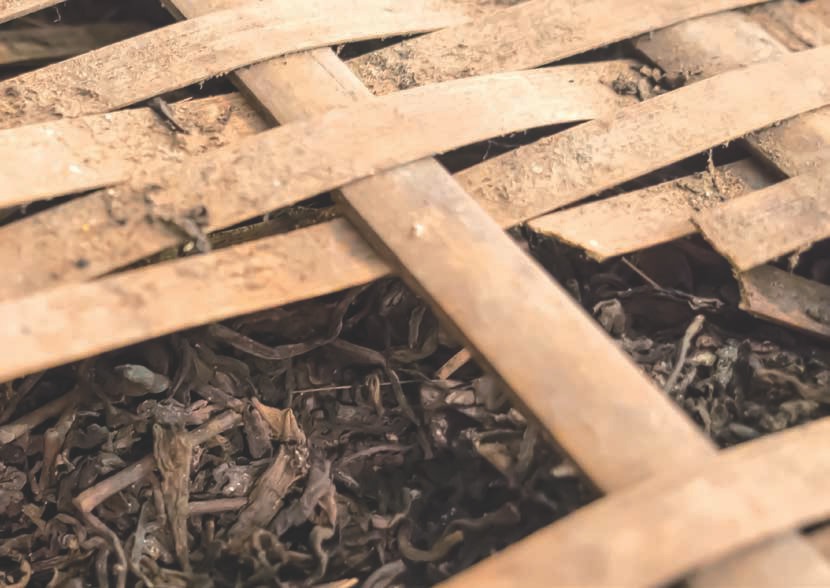
Liu Bao tea is from Cangwu (蒼梧) County, Wuzhou City (梧州), Guangxi Province (廣西). It has been one of the twenty-four most famous teas in China since the Jiaching Era (17961820). However, to the Chinese diaspora in Southeast Asia, especially in Malaysia, the flavor of this tea is strongly tied to a century-old nostalgia. So when we decided to write about Liu Bao tea, the first thing that came to mind was to visit teashops in Malaysia, instead of Wuzhou City in Guangxi. We should go to Malaysia to take a look at how the Chinese people there drink Liu Bao tea. Where do they buy Liu Bao tea? And how is it woven into the local culture and economy of everyday life in Malaysia?
Traditionally, the most important seven daily necessities for Chinese were firewood, rice, oil, salt, soy sauce, vinegar, and tea. But after a trip to Malaysia, you may be surprised to find that tea leads that list, especially Liu Bao!
There were three major ethnic groups that emigrated to Malaysia from China: the Hakkas from Chaozhou (潮州), the Minnan people from Anxi (安溪), and the Southerners from Guangdong (廣東) and Guangxi provinces. In the beginning, these three groups of overseas Chinese reminisced of their home over different cups of tea: the Hakka people drank Wuyi tea, Anxi people drank Tieguanyin, while the Southerners drank Liu Bao tea. As time went on, however, all the Chinese expatriates started drinking Liu Bao.
Our first stop was Ipoh, a fast-growing mining city during the 1920's that has since lost most of its population due to the closing of the tin mines in the 1970's. Nevertheless, there are some beautiful buildings from that era that still remain in the old town. Along with the miners and their families, the once popular Liu Bao tea has moved away.
Long ago, Liu Bao tea and the mining industry were tightly knitted together. According to Mr. Huang who lives in Kuantan, his father came to Malaysia in 1902 to escape a long period of war. Ships with up to one thousand refugees arrived in Malaysia regularly. These migrants came to find jobs in the local tin mines. However, out of the one thousand Chinese who arrived with Mr. Huang's father on the boat, he was one of only two lucky survivors left standing months later! "You buried one body in the morning and you became the body to be carried to the tomb in the afternoon. This happened everyday", says Mr. Huang, describing the poor working conditions of those times.
Malaysia is a tropical country, so cave-ins were very common due to the humidity and constant gusty wind. Beyond the danger of collapse, miners were exposed to moist tunnels and blasting winds all the time. The panning miners working outside in the water weren't any better off because they stood in the river barefoot under a blazing sun all day long. The extreme weather, long working hours, and foreign food and water dimmed all their dreams, which faded like the light in the mines.
Under such terrible circumstance, many Chinese miners had a need for tea, and Liu Bao became an important necessity they brought along with them to Malaysia. According to Traditional Chinese Medicine, tea is usually cold in nature; and yet Liu Bao tea is actually mild. It has the amazing ability to be cold or hot as needed. In addition to the basic health benefits it shares with all tea, Liu Bao tea is special because it can dispel dampness and heat, soothe the lungs, cool the body down, and flush out excess Qi. As a result, Liu Bao tea was perfect for the miners who worked in Malaysia. It became essential to have a big pot of Liu Bao tea brewing at the entrance to the tin mines. Miners lined up at the entrance with a pot of porridge for lunch in their left hands and Liu Bao tea in their right. Liu Bao tea was a vital medicinal drink to keep them alive as well as a constant companion - a familiar flavor of home. It is said that when mines placed ads to recruit miners, the Chinese would choose the mine with complimentary Liu Bao tea. There are also instances of miners refusing to work at mines that didn't provide Liu Bao.
At its peak, Ipoh was very lively with busy mines all over the area. Because of the high demand for Liu Bao tea, teashops in Hong Kong and Guangxi opened local branches in Ipoh. Chen Chun Lan/PL Teashop (陳春蘭/寶蘭茶行) from Hong Kong was the most famous and influential of these, selling Liu Bao tea exclusively. It is said that they imported several thousand baskets (each with a capacity of 20-50kg/45-110 lbs.) annually. PL Liu Bao tea is a highly sought-after vintage these days.
Liang Ruisheng (梁瑞生) founded a teashop that bore his name at the peak of tin mining. It was later sold to Yi Huicai during the 1940's, and is now managed by the second generation, Yi Songqiang. The brand "Sirui (四瑞)" was developed in the 1940's, and became so famous everywhere throughout Malaysia that many teashops and tea drinkers even now use the name "Sirui" as a generic way of asking for Liu Bao tea.
When looking for teashops in the old town area of Ipoh, Ruizhen (瑞珍) is the best choice. Li Lichi established the Ruizhen Drugstore in Anxi in 1918 and his son Li Yizhen opened a store in Malaysia in 1924. The mining industry helped Malaysia's economy strengthen, encouraging a larger and better tea market. The mesmerizing ambiance, old tea brands painted on the walls, antique doors and tansu (drawers), not to mention the shiny floor polished by decades of heavy traffic all reveal how popular it was back in the day...
In Malaysia, tea is so popular and crucial that it can be found in many stores other than teashops. Often times, most drugstores or Chinese herbal apothecaries have a section exclusively for tea right at the entrance, with higher visibility than rice or salt! Ample choices of tea can be found in Chinese Medicine shops because the locals consider tea as medicine, which it was for centuries, or even millennia, to all Chinese people. Liu Bao tea can also be found in shops selling paraphernalia for ancestor worship, because it is one of the common offerings given to ancestors. If you ask a waiter at a restaurant for Liu Bao tea, they'll not only have it for sale, but will offer you choices of both new and old vintages! While strolling through the old town, we saw an old man riding a bicycle to Liang Ruisheng's old teashop to buy Liu Bao tea. The owner wrapped the tea up in a piece of brown parcel paper and tied it with a piece of red plastic string. The old man hung the package on the handlebars of his bicycle and rode away. Nowadays, such a scene is only preserved in Ipoh, Malaysia.
There are all kinds of Liu Bao tea in every store in the old town district, and yet you have to go to the experts to taste the oldest Liu Bao tea. But how is the Liu Bao tea dated? How are the numbers and codes on the labels of the tea baskets deciphered? Why is it that all the very well aged Liu Bao tea was only consumed later on? Did the Liu Bao tea get here directly from China or did it all have to go through Hong Kong? And why is there a saying that "One can't tell the vintage from the package, nor can one tell if it is new or old from the leaves." There are many unsolved mysteries about Liu Bao tea that even the most experienced experts cannot explain.
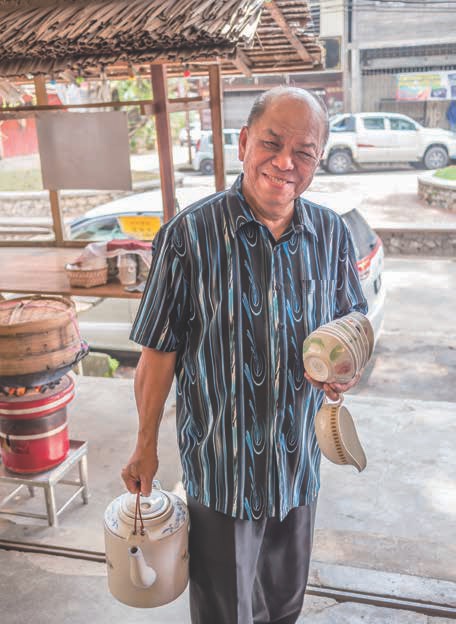

We roamed around half of Malaysia searching for answers in both old and new teahouses and teashops, from Ipoh to Taiping, through Kuala Lumpur to Kuantan, and then returning to Kuala Lumpur. After tasting over fifty kinds of Liu Bao tea and photographing almost a hundred baskets, we found ourselves trapped in an endless cycle of understanding some aspects of this magic tea, only to fall back into the dark of a confusion as pronounced as when we started. In the beginning, we were able to identify some teas correctly. Yet after a few more rounds of tasting different kinds of Liu Bao, all the flavors were mixed up and we got confused. Then, after a while, we managed to know certain teas better. But then we'd get confused again, not knowing the vintage or even the age of the tea, as if we'd stumbled into a labyrinth of elusive tea that varied so much that you couldn't tell a tea you had tasted just the day before. There is a saying that "the water for brewing puerh is deep", meaning that there is a lot to be learned about puerh tea. Over the course of this trip, we realized that the water for Liu Bao is not any shallower!
There are many reasons why it is difficult to date Liu Bao tea: First of all, Liu Bao tea was simple back then (much like puerh), so after the tea was imported to Malaysia, packaging documentation and/or importation dates were not important. Secondly, even though almost all the Liu Bao tea originated in Guangxi, it was sometimes packaged in Hong Kong or even in Ipoh. And tea companies had their own different coding systems for the labels on the baskets. Decades later, those codes are not traceable or decipherable. Thirdly, for many different reasons, there was little to no tea produced in Wuzhou between 1958 and 1989. In the beginning of that era, tea companies in Hong Kong used leaves from Yunnan and Sichuan and marketed such tea as "Liu Bao tea". During the 1980's, teashops in Malaysia imported tea from Thailand and Myanmar and packaged them into baskets and sold them as "Liu Bao tea" as well. As a result, we have only the baskets and the tea leaves left to tell the tale of any tea's vintage and/or origin. For example, the better the craftsmanship of the basket, the older the tea is. And sometimes, the labels on the baskets reveal the period of time when the tea was imported. But since Liu Bao was often aged before it was even sold from Guangxi, and then often aged again in Hong Kong, this says little about the year of production.
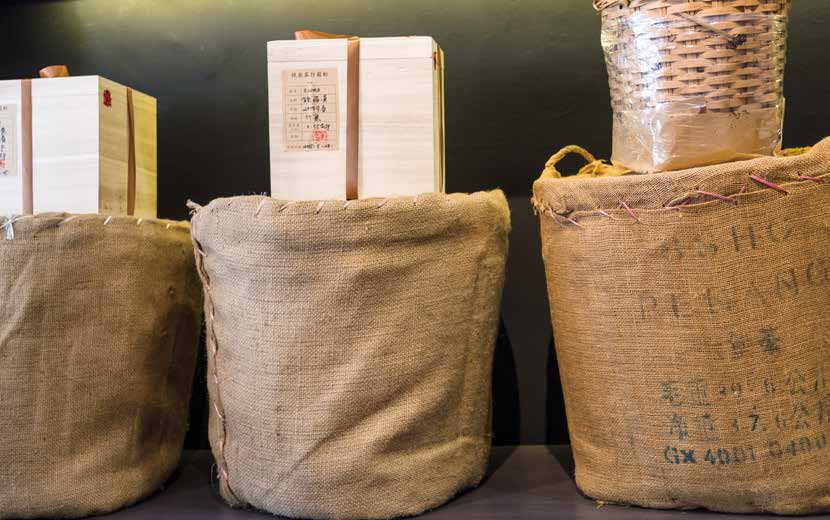
Miss Xiuzhen Zhang (張秀珍) from Huizhen Ge (匯珍閣) led us from Ipoh to Taiping. Taiping is one of the oldest cities in Malaysia, with the oldest harbor and railway station. In the old days, people lived around the mines there. Now the old tin mines are gone, replaced by a lovely artificial lake. As a result of the beautiful lake and cool breezes, Taiping has become a popular vacation destination in Malaysia. We started our exploration of old Liu Bao tea in Taiping. Tea connoisseur Guoxing Cai (蔡國興) started drinking Liu Bao tea when he opened a tea house in 1993. He explained why it is difficult to date Liu Bao tea: "In the early period, there was no direct trade between Malaysia and China, so tea shops had to purchase tea from Hong Kong, or tea had to be shipped through Singapore. Since Liu Bao tea is a black tea, and the post-production fermentation process is so vital to the tea, the condition of the storage has a huge impact on the quality of the tea. The fact that the natural environments of Hong Kong and Malaysia are very different contributes to the huge variety of Liu Bao tea in the market. However, through comparing some aspects of the tea, and drinking more varieties, it is possible to place a tea into a relative timeframe."
Mr. Cai categorized Liu Bao tea into three major periods: "There is a lively, slightly subdued sweet taste to the tea made in or before the 1960's. The tea made in the 70's and 80's, on the other hand, tastes a bit more brisk, and the color is more reddish-yellow. During the last period, the color of the tea liquor has gotten lighter, and the storage smell has grown stronger, especially around 2007. After that, the market demand changed and very little Liu Bao tea has since been aged after fermentation in the traditional way. Because of the popularity of puerh tea, Liu Bao is now produced with a greener, more raw profile. But there is a re-emerging trend to make Liu Bao tea in a more traditional way, with fermentation and aging."
Mr. Cai prepared different teas for us to taste. The first group were the "Eight Mid-green (八中青)", SSHC, and KWF (廣匯豐) from the 1970's. The second round was Liu Bao loose teas (not from big baskets) made by Wuzhou, KWF premium Liu Bao loose tea leaves, and the big leaves, which are from a basket. The third batch was the China Tea (中茶) tea bags. Then we tasted premium vintage Liu Bao, Zhong Cha and LLLL367 (寶蘭) from the 50's and 60's. Last but not least, we savored collector Mr. Li's YSC1, which is unlike any other Liu Bao tea. It has a pungent ginseng aroma and the tea liquor looks clear and transparent.

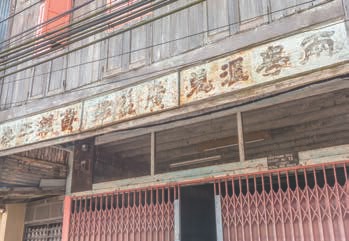
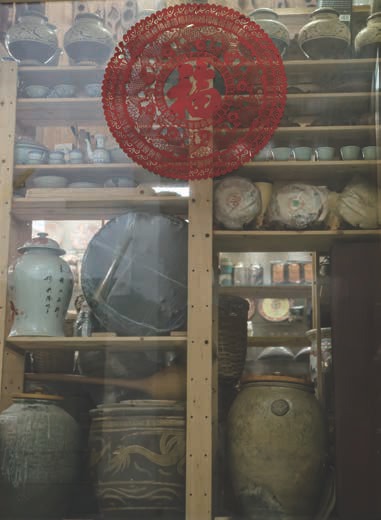
After tasting more than ten different varieties of Liu Bao tea, the famous betel nut and ginseng flavors of Liu Bao left a very strong impression on us. There were many other tastes and fragrances, ranging from refined sweetness, briskness, thick ginseng to sweet camphor... It was as if we'd attended a Liu Bao carnival with a wide spectrum of colors and fanfare.
The following day, we went back to Ipoh to visit another tea connoisseur, Mr. Zhong (鍾) who started to savor Liu Bao tea in 1975 when he moved to Ipoh. He felt sad talking about Liu Bao tea because most tea enthusiasts in the early period did not know how to appreciate this "Essence of Malaysian Tea". Ironically, people finally started paying more attention to old Liu Bao tea when the price of old puerh became too expensive.
According to Mr. Zhong, people in Wuzhou, China, where Liu Bao originates from, have never consumed much Liu Bao tea because almost all of the tea was exported. He says Hong Kong was the location where the tea was most often finished, and yet not many people drank Liu Bao tea there, either. Most of the Liu Bao tea was consumed in Malaysia. In Ipoh, the miners drank up the lower-grade Liu Bao tea while the higher-grade tea was geared toward the rich bourgeois, mine officials and restaurants (the last of which we discovered later). After the closing of the tin mines in the 70's, there was a large surplus of premium tea. Three decades later, old high-quality Liu Bao tea re-surfaced in the market and people finally recognized its value.
Mr. Zhong went on to share the three key elements in brewing fine Liu Bao tea: very hot water, adequate tea leaves, and antique Yixing teapots. For example, for a teapot with a capacity of 200ml, Mr. Zhong suggests using 14 grams to make a nice pot of tea. He suggests that once you’ve mastered brewing, you can differentiate the nuances of various vintages more easily.
Then we went from Western Malaysia to Kuantan, Eastern Malaysia. Tea master Lin Ping Xiang (林平祥) and Shunchang Qiu (邱順昌) took us to a mountain along the sea shore to watch the sunrise while sipping fantastic Liu Bao tea.
We left at 4am to climb Lembing Mountain in the pitch dark. We arrived at the peak before the crack of dawn to view the sunrise. To our surprise, the masters were very prepared, bringing a full tea set with them. Besides a nice picnic blanket, they had exquisite antique Yixing pots, Ming Dynasty porcelain cups, charcoal, a brazier and, of course, very fine water. They even brought cushions for us all to sit on. These Chajin understand tea! The coals heating clean spring water, and the most suitable teaware were the perfect combination, producing a pot of tea that left us savoring the flavor and fragrance for hours. Master Lin said that in gongfu tea none of the important elements can be compromised, helping the tea to reach its full potential, unfolding all its subtleties. After that day, I’d have to agree!
We tasted sweet YSC Old Label Liu Bao tea to quench our thirst and catch our breath after the long hike up the mountain. Then we picked the stronger Zhong Cha to give us a boost and start the day off right. After that PL LLLL367 was ready, and the first rays of sun shone exquisitely on the reddish tea liquor. This momentary union of Heaven, Earth, Tea and human beings moved us beyond words! We fell silent… The fourth tea was the "Four Golden Coins (四金錢)" from Shenchang Xuanzhuang (慎昌選莊). A soft sweetness unfolded alongside the twilight of a beautiful dawn! Then came the grand finale, "Joy to the World" (Pu Tian Gong Qing 普天 共慶), Diamond Grade Yuandu (原度), the best Liu Bao there is! The rich aroma spread out from the tip of our tongues like a drop of water rippled across the surface of a pond, just as the morning sun lit up the surroundings and our souls... As we sat on the highest spot in Kuantan, savoring such fantastic Liu Bao tea, the spectacular sunshine brightened the long-forgotten Liu Bao tea culture of Malaysia.
The various fantastic, old Liu Bao teas we'd tasted on this trip proved that there are extremely high-quality Liu Bao teas out there! Realizing that our previous misconception of Liu Bao as a simple, lower-quality tea was entirely wrong, we wanted to make the most of this trip in Malaysia to better explore the enchantment...
We reached our final destination, Kuala Lumpur, which has had the highest tea traffic in Malaysia since the 1930's. As it's the capital, and so near the harbor, all major tea importers had their offices and warehouses here. The top five tea shops, Kong Wooi Fong Tea Merchants (廣匯豐), Lianlongtai (聯隆泰), Guangfuyuan (廣福源), Nanlong (南隆) and Yushengxiang (裕生祥) all established storefronts in the bustling metropolitan of KL. The antique sign at Kong Wooi Fong gives away the century of history inside. The senior general manager, Mr. Liu (劉) pointed out that in the olden times the top three grades of tea were sold to restaurants exclusively. At that time, rich people frequented restaurants for the sake of the high-quality tea as much as the food. Back then, the price differences among different grades of tea were not much by today's standards, so the restaurants which offered the best quality tea would attract more costumers. As a result, almost all restaurants purchased premium Liu Bao tea to ensure a full house. So, Liu Bao tea wasn't exclusively for tin miners. Hearing that was a very important piece in the puzzle, since I'd thought that Liu Bao tea was only imported for miners. In addition, the various fantastic, old Liu Bao teas we'd tasted on this trip, from Ipoh to Taiping to Kuantan, proved that there are extremely high-quality Liu Bao teas out there! Realizing that our previous misconception of Liu Bao as a simple, lower-quality tea was entirely wrong, we wanted to make the most of this trip in Malaysia to better explore the enchantment of Liu Bao. Therefore, we visited several teashops in KL.
For several decades, Ms. Meiling Chao (趙美玲), founder of Cha-no-yu Teahouse has put a lot of effort into promoting Malaysian tea culture. In 2014, she organized a grand event: "Rediscovering the Splendor of Liu Bao Tea" in KL to give Liu Bao tea more exposure. "Liu Bao tea is at the root of Malaysian culture. As a tea culture aficionado and promoter, I am obliged to make people aware of the splendor of Liu Bao tea." While tasting old Liu Bao tea with Ms. Chao, her comments echoed the flavor of the tea...
Throughout our trip, we savored and compared different aged Liu Bao tea in their flavors, fragrances and textures. And yet the full significance of Liu Bao in the history of tea, and a true exploration and appreciation of the nuances it offers, must ferment over time...

